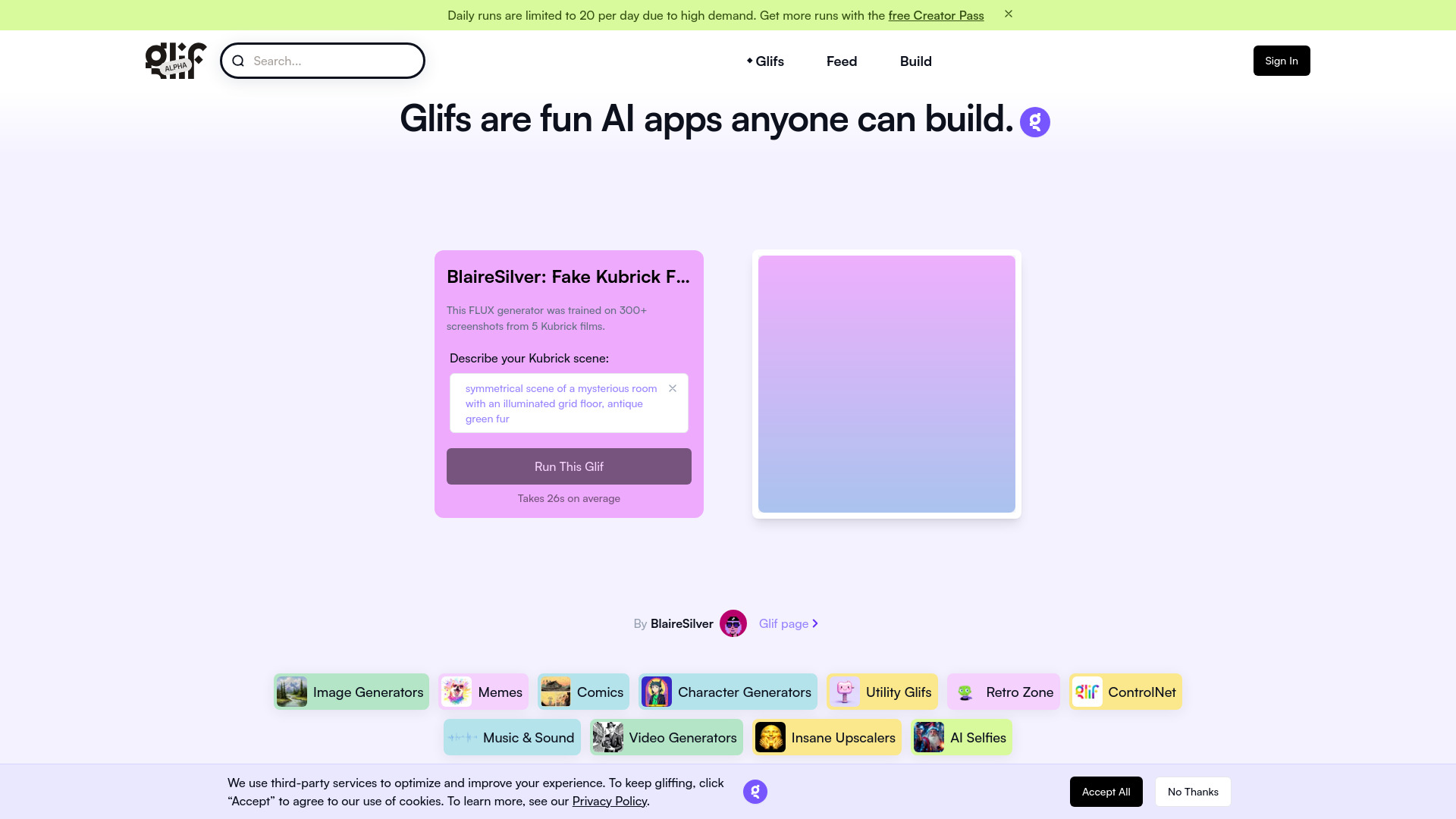- Home
- AI Image Generator
- Glif

Glif
Open Website-
Tool Introduction:Build AI mini-apps, flows and chatbots with LLMs in an all-in-one sandbox.
-
Inclusion Date:Oct 21, 2025
-
Social Media & Email:
Tool Information
What is Glif AI
Glif AI is an all‑in‑one platform for building AI mini‑apps, workflows, and chatbots. It lets you combine LLMs, image generators, and ComfyUI nodes into reusable pipelines, then deploy them as interactive applications. With a visual editor, prompt controls, variables, and a rapid testing sandbox, Glif AI streamlines the path from idea to production. Use it to prototype AI agents, automate content creation, orchestrate multi‑step tasks, or embed conversational experiences—while keeping configuration, execution, and deployment in one place.
Glif AI Main Features
- Visual workflow builder: Drag‑and‑drop nodes to design multi‑step AI workflows without heavy coding.
- LLM orchestration: Connect large language models, manage prompts, system messages, and tool use across steps.
- Image generation: Integrate image models and ComfyUI pipelines for creative and programmatic visuals.
- Chatbot creation: Turn workflows into conversational agents with memory, context, and branching logic.
- Data flow and variables: Pass inputs/outputs between nodes, reuse variables, and structure responses reliably.
- Sandbox testing: Iterate quickly with live previews, test inputs, and versioned changes before publishing.
- Deployment options: Publish as shareable mini‑apps, embed in websites, or expose as callable endpoints where available.
- Templates and cloning: Start from ready‑made blueprints or duplicate community apps to accelerate builds.
- Integrations: Call external APIs and tools to enrich your workflows with data and actions.
- Monitoring: Inspect runs, logs, and intermediate outputs to troubleshoot and improve reliability.
Who Should Use Glif AI
Glif AI suits product teams, no‑code/low‑code builders, marketers, designers, and creators who need to prototype and ship AI features quickly. It also helps support teams building assistants, agencies delivering client automations, educators crafting interactive lessons, and researchers testing multi‑modal pipelines that mix LLMs with image generation and custom logic.
How to Use Glif AI
- Sign up and create a new mini‑app or workflow project.
- Open the visual builder and add nodes for LLMs, image generation, and any ComfyUI components you need.
- Configure prompts, system instructions, parameters, and variables for each step.
- Connect nodes to define data flow, branching, and error handling.
- Use the sandbox to run test inputs, inspect outputs, and refine prompts.
- Add a chat interface if you’re building a conversational agent.
- Optionally connect external APIs or data sources to enrich responses.
- Publish the mini‑app, share a link, embed it on your site, or trigger it programmatically where supported.
Glif AI Industry Use Cases
In e‑commerce, teams build product advisors that combine LLM reasoning with on‑brand image generation. Marketing teams automate campaign assets by chaining copywriting prompts and ComfyUI image workflows. Customer support deploys guided chatbots that triage issues and hand off to human agents. In education, interactive lesson bots generate examples and visuals. Creative studios prototype concept art pipelines that turn briefs into consistent images plus captions.
Glif AI Pricing
Glif AI provides multiple plan options designed to let users start quickly and scale with usage, features, and collaboration needs. Specific tiers, limits, and billing models may change over time. For the most current details, including any free access or trials, please refer to the official pricing page.
Glif AI Pros and Cons
Pros:
- Fast, visual way to build LLM and image workflows without heavy engineering.
- Combines chatbots, automation, and ComfyUI image pipelines in one place.
- Sandbox testing shortens iteration cycles and improves reliability.
- Reusability via templates and cloning accelerates new projects.
- Flexible deployment as shareable mini‑apps or embedded experiences.
- Supports mixing external APIs and data for richer functionality.
Cons:
- Advanced scenarios may still require scripting, custom APIs, or developer support.
- Model availability, rate limits, and costs depend on connected providers.
- Complex workflows can become harder to manage without clear documentation.
- Enterprise controls and governance features may vary by plan.
Glif AI FAQs
-
Question 1: Does Glif AI require coding?
No. It is designed for no‑code/low‑code building via a visual editor, with options to call external APIs for custom logic when needed.
-
Question 2: Which models does it support?
Glif AI orchestrates LLMs and image models and integrates with ComfyUI pipelines. Available providers and nodes depend on your configuration.
-
Question 3: Can I deploy a chatbot to my website?
Yes. Workflows can be published as interactive mini‑apps and embedded on websites or shared via links.
-
Question 4: How are data and privacy handled?
You control what inputs and outputs are processed within your workflows. Review the official documentation for data handling and retention details.
-
Question 5: Is there an API to trigger workflows?
Programmatic triggering and integrations may be available depending on your setup. Check the documentation for current API and webhook options.
-
Question 6: Can I fine‑tune models inside Glif AI?
Glif AI focuses on orchestration. You can structure prompts, chain tools, and integrate retrieval; model fine‑tuning, if needed, is typically done with the model provider.


